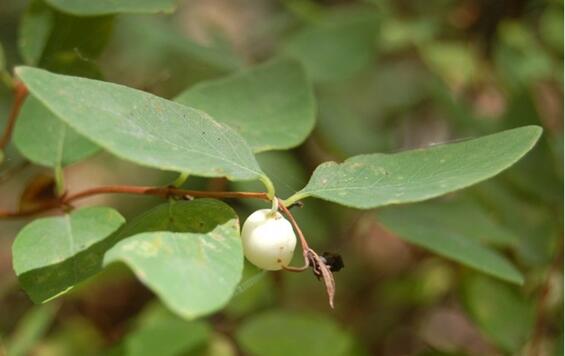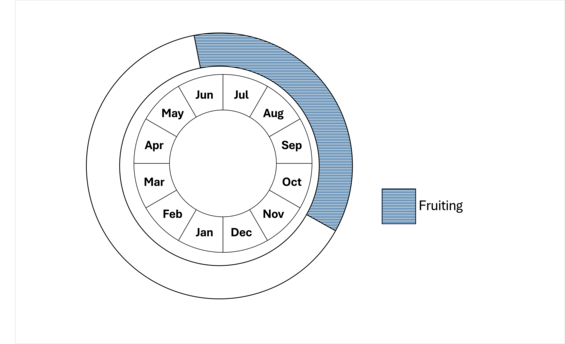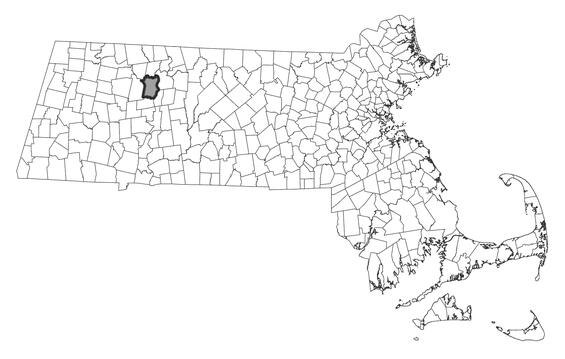- Scientific name: Symphoricarpos albus var. albus
- Species of Greatest Conservation Need (MA State Wildlife Action Plan)
- Endangered (MA Endangered Species Act)
Description

Snowberry, with the distinctive white berry. Photo: Charles Eiseman.
Snowberry (Symphoricarpos albus var. albus) is a low, thicket-forming shrub of the honeysuckle family (Caprifoliaceae). It is found in sunny, dry, rocky habitats on limestone and sandstone. This species gets its name from its white berrylike fruits.
Snowberry has opposite, oval to nearly round, entire (untoothed) but occasionally lobed leaves, which are 1-5 cm (0.4-2 in) long and 1-3 cm (0.4-1.2 in) wide. They are usually hairy on the undersides. The 5-8 mm (0.2-0.3 in) flowers are pink and bell-shaped, with five lobes emanating from a slightly lopsided tube, and are borne in small terminal clusters. The white fruits measure 6-10 mm (0.2-0.4 in), each containing a pair of oval, 4-5 mm (0.2 in) long nutlets. Young twigs may be smooth or finely hairy and are light brown, turning purplish to gray as they mature. The bark becomes shredded with age, and the whole plant may be up to 1 m (3.3 ft) high.
The ornamental western snowberry (Symphoricarpos albus var. laevigatus), native to western North America, is occasionally found escaped to roadsides. Its twigs and leaves are smooth, not hairy, and it can be up to 2 m (6.6 ft) high. The flowers are typically in elongate terminal racemes, and the fruits are larger at 10-15 mm (0.4-0.6 in) in diameter.
Snowberry might also be confused with various honeysuckles (Lonicera spp.). Morrow’s honeysuckle (L. morrowii) an invasive species from Asia now commonly occurs in many habitats in Massachusetts. It is typically well over 1 m (3.3 ft) high and has creamy white to yellow flowers with curled-back petals. Honeysuckles in general differ from snowberries in having flowers over 1 cm that are often two-lipped, and with several-seeded fruits that may be various colors but never white.
Life cycle and behavior
Flowers bloom in June. Immature fruits are present by the end of June and ripe fruit often remain attached through the winter.

Population status
Snowberry is listed under the Massachusetts Endangered Species Act as endangered. All listed species are protected from killing, collecting, possessing, or sale and from activities that would destroy habitat and thus directly or indirectly cause mortality or disrupt critical behaviors.
Massachusetts Natural Heritage & Endangered Species Program database has 1 record from 1 county (Franklin). That record is within the last 25-year period.
Distribution and abundance
Snowberry is at its eastern range limit in western Massachusetts. It occurs from Quebec to western Virginia, west to British Columbia and Colorado.

Distribution in Massachusetts. 1999-2024. Based on records in the Natural Heritage Database.
Habitat
The single known population of snowberry in Massachusetts is on a dry, open, grassy, very steep slope of loose, somewhat calcareous sandstone. The species has also been reported as growing “in a groove on a low limestone hill.”
Healthy habitats are vital for supporting native wildlife and plants. Explore habitats and learn about conservation and restoration in Massachusetts.
Threats
Erosion and shading have been noted as potential threats at the site where snowberry is currently found.
Conservation
Selective removal of trees may be considered if shading becomes an issue. All active management of rare plant populations (including invasive species removal) is subject to review under the Massachusetts Endangered Species Act, and should be planned in close consultation with MassWildlife’s Natural Heritage & Endangered Species Program.
References
Hoffmann, R. 1904. Notes on the rare flora of Berkshire County. Rhodora 6: 206.
Sorrie, B.A. 1987. Notes on the rare flora of Massachusetts. Rhodora 89: 113-196.
Contact
| Date published: | May 7, 2025 |
|---|